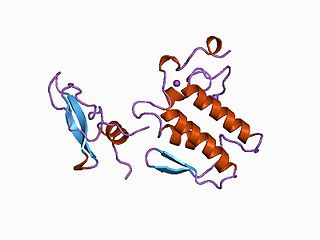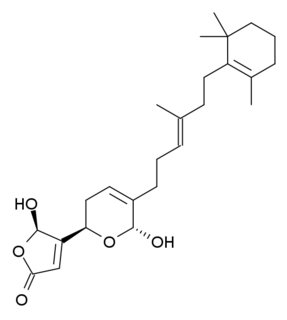
A phospholipase is an enzyme that hydrolyzes phospholipids into fatty acids and other lipophilic substances. There are four major classes, termed A, B, C and D, which are distinguished by the type of reaction which they catalyze:

Phospholipases A2 (PLA2s) EC 3.1.1.4 are enzymes that cleave fatty acid in position two of phospholipids, hydrolyzing the bond between the second fatty acid “tail” and the glycerol molecule. This particular phospholipase specifically recognizes the sn-2 acyl bond of phospholipids and catalytically hydrolyzes the bond, releasing arachidonic acid and lysophosphatidic acid. Upon downstream modification by cyclooxygenases or lipoxygenases, arachidonic acid is modified into active compounds called eicosanoids. Eicosanoids include prostaglandins and leukotrienes, which are categorized as anti-inflammatory and inflammatory mediators.

Phosphoinositide phospholipase C (PLC) is a family of eukaryotic intracellular enzymes that play an important role in signal transduction processes. These enzymes belong to a larger superfamily of Phospholipase C. Other families of phospholipase C enzymes have been identified in bacteria and trypanosomes. Phospholipases C are phosphodiesterases.
Phospholipase D (PLD) is an enzyme of the phospholipase superfamily. Phospholipases occur widely, and can be found in a wide range of organisms, including bacteria, yeast, plants, animals, and viruses. Phospholipase D's principal substrate is phosphatidylcholine, which it hydrolyzes to produce the signal molecule phosphatidic acid (PA), and soluble choline. Plants contain numerous genes that encode various PLD isoenzymes, with molecular weights ranging from 90 to 125 kDa. Mammalian cells encode two isoforms of phospholipase D: PLD1 and PLD2. Phospholipase D is an important player in many physiological processes, including membrane trafficking, cytoskeletal reorganization, receptor-mediated endocytosis, exocytosis, and cell migration. Through these processes, it has been further implicated in the pathophysiology of multiple diseases: in particular the progression of Parkinson's and Alzheimer's, as well as various cancers. PLD may also help set the threshold for sensitivity to anesthetia and mechanical force.

Oxyphenbutazone is a nonsteroidal anti-inflammatory drug (NSAID). It is a metabolite of phenylbutazone.
There are two known parathyroid hormone receptors in mammals termed PTH1R and PTH2R. These receptors bind parathyroid hormone and are members of the GPCR family of transmembrane proteins.

Phospholipase B, also known as lysophospholipase, is an enzyme with a combination of both PLA1 and PLA2 activities; that is, it can cleave acyl chains from both the sn-1 and sn-2 positions of a phospholipid. In general, it acts on lysolecithin.

Phospholipase A1 encoded by the PLA1A gene is a phospholipase enzyme which removes the 1-acyl. Phospholipase A1 is an enzyme that resides in a class of enzymes called phospholipase that hydrolyze phospholipids into fatty acids. There are 4 classes, which are separated by the type of reaction they catalyze. In particular, phospholipase A1 (PLA1) specifically catalyzes the cleavage at the SN-1 position of phospholipids, forming a fatty acid and a lysophospholipid.

Phospholipase C, gamma 1, also known as PLCG1,is a protein that in humans involved in cell growth, migration, apoptosis, and proliferation. It is encoded by the PLCG1 gene and is part of the PLC superfamily.

Phospholipase D1 (PLD1) is an enzyme that in humans is encoded by the PLD1 gene, though analogues are found in plants, fungi, prokaryotes, and even viruses.

Phospholipase D2 is an enzyme that in humans is encoded by the PLD2 gene.
In enzymology, a glycosylphosphatidylinositol diacylglycerol-lyase is an enzyme that catalyzes the chemical reaction

Cytosolic phospholipase A2 is an enzyme that in humans is encoded by the PLA2G4A gene.

1-Phosphatidylinositol-4,5-bisphosphate phosphodiesterase gamma-2 is an enzyme that in humans is encoded by the PLCG2 gene.

Phospholipase C (PLC) is a class of membrane-associated enzymes that cleave phospholipids just before the phosphate group (see figure). It is most commonly taken to be synonymous with the human forms of this enzyme, which play an important role in eukaryotic cell physiology, in particular signal transduction pathways. There are thirteen kinds of mammalian phospholipase C that are classified into six isotypes (β, γ, δ, ε, ζ, η) according to structure. Each PLC has unique and overlapping controls over expression and subcellular distribution. Activators of each PLC vary, but typically include heterotrimeric G protein subunits, protein tyrosine kinases, small G proteins, Ca2+, and phospholipids.

β-Bungarotoxin is a form of bungarotoxin that is fairly common in Krait venoms. It is the prototypic class of snake β-neurotoxins. There are at least five isoforms, coded β1 to β5, assembled from different combinations of A and Bchains.

Manoalide is a calcium channel blocker. It has antibiotic, analgesic and anti-inflammatory effects and is found in some sponges, including the West Pacific species Luffariella variabilis. Its functions are made possible by the permanent blockage of phospholipase A2 and C with lysine residues. This could be made possible through the functional groups incorporated in gamma-hydroxybutenolide, alpha-hydroxydihydropyran and the trimethylcyclohexenyl. The gamma-hydroxybutenolide ring is present in the reaction between manoalide and phospholipase A2, the hemiacetal in alpha-hydroxydihydropyran is needed for permanent binding and hydrophobic trimethylcyclohexenyl ring makes it possible for non-bonded interactions to interact between manoalide and phospholipase A2 to strengthen the reaction. Due to its potential of permanent inhibition, it was made possible for it to take part in oral cancer and Hepatitis C research.

A lipase is any enzyme that catalyzes the hydrolysis of fats (lipids). Lipases are a subclass of the esterases.

SKF-83,959 is a synthetic benzazepine derivative used in scientific research which acts as an agonist at the D1-D2 dopamine receptor. It behaves as a full agonist at the D1 protomer and a high-affinity partial agonist at the D2 protomer. It was further shown to act as an allosteric modulator of the sigma-1 receptor. SKF-83,959 is a racemate that consists of the R-(+)- and S-(−)-enantiomers MCL 202 and MCL 201, respectively. SKF-83,959 inhibits sodium channels as well as delayed rectifier potassium channels.
Crotoxin (CTX) is the main toxic compound in the snake venom of the South American rattlesnake, Crotalus durissus terrificus. Crotoxin is a heterodimeric beta-neurotoxin, composed of an acidic, non-toxic and non-enzymatic subunit (CA), and a basic, weakly toxic, phospholipase A2 protein (CB). This neurotoxin causes paralysis by both pre- and postsynaptic blocking of acetylcholine signalling.













